1lumen selects and reviews products personally. We may earn affiliate commissions through our links, which help support our testing.
Fenix LR80R review

Fenix LR80R specifications
| Brand/model | Fenix LR80R |
|---|---|
| Category | High lumen flashlight |
| LED | 6 X Luminus SST70 |
| Max. Lumens | 18,000 lm |
| Max. Beam intensity / distance | 318,000 cd |
| Battery config. | Battery pack |
| Onboard charging | Yes |
| Modes | 10 |
| Blinkies | Strobe, SOS |
| Reflector | Smooth |
| Waterproof | IP68 |
| Review date | July 2022 |
Introduction:
Fresh off the epic experience that was the Wuben A1, Fenix graciously sent me their own flagship flashlight to review. Woohoo! Christmas came early! Fenix is probably the biggest name in consumer-grade flashlights, and I’ve reviewed quite a few of their lights ranging from tiny keychain lights (the ELite) to their excellent tactical and duty flashlights.
In the professional-use market, they make some of the best lights out there, with many versions designed for high output and long throw capabilities. Today I’ll be taking a look at the Fenix LR80R. This is Fenix’s top of the line offering in their LR series line, consisting of the LR35R, LR40R, and LR50R. These are larger, higher output, longer range lights with multiple emitters and large battery packs for sustaining high output and increased runtimes.
The LR80R is roughly based on the LR50R, albeit in a much larger form factor, extra SST70s for more output, and a larger battery. While it doesn’t match the A1 for throw, it comes close in output, and is a much more portable option (not to mention ½ the price!). I’m super-excited to check it out so let’s dig in.
Package quality.
The Fenix LR80R comes in a very nice retail package with lots of colorful graphics with Fenix’s signature orange and black highlights with pictures and features with specs all over. It’s eye-catching and the box is large. Inside the LR80R was secured between two foam blocks with a box of accessories in between. Here’s what you get:
- Fenix LR80R (battery pack makes up the body of the light)
- Shoulder strap
- Spare o-ring
- Dual port charging adapter
- USB type C with type A adapter cable
- Carry handle (attached)
- Threaded adapter
- User manual
- Warranty card
- Literature
Like all professional-use lights, this is an extensive amount of kit, and it’s everything needed to get up and running. The battery was charged up and had an isolator between the contacts to prevent it from dumping during storage. The threaded adapter is stainless steel, and the multi-USB cable is a very high-quality braided unit with a captured USB type A to type C connector. The charging adapter is a dual-port unit with a USB type A for up to 5 V 2.4 A, and a USB type C with PD up to 45 watts. The adapter also seems high quality. It’s not dodgy at all and is properly rated by UL, not some hodgepodge no-name brand so it will be safe to use.

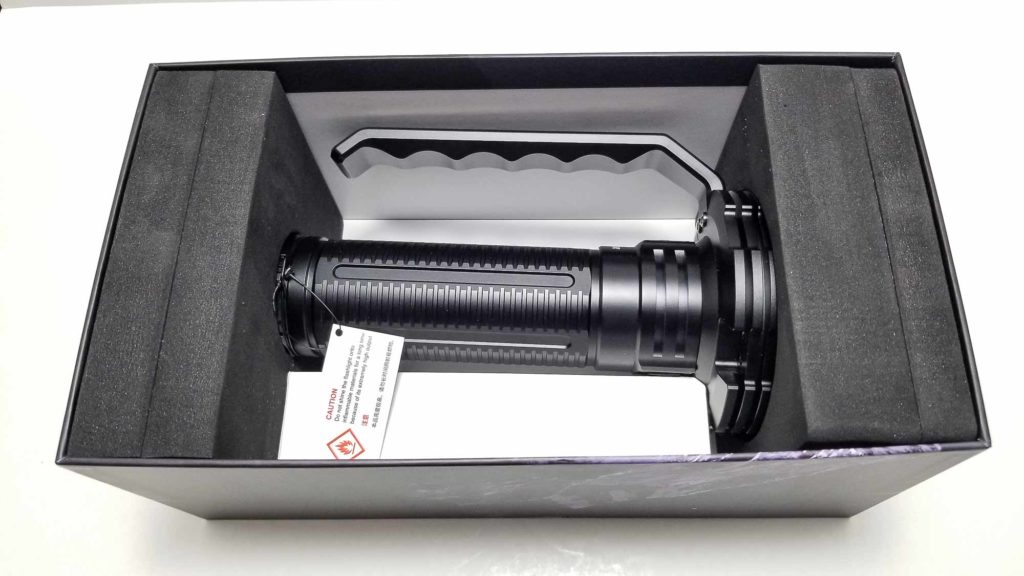
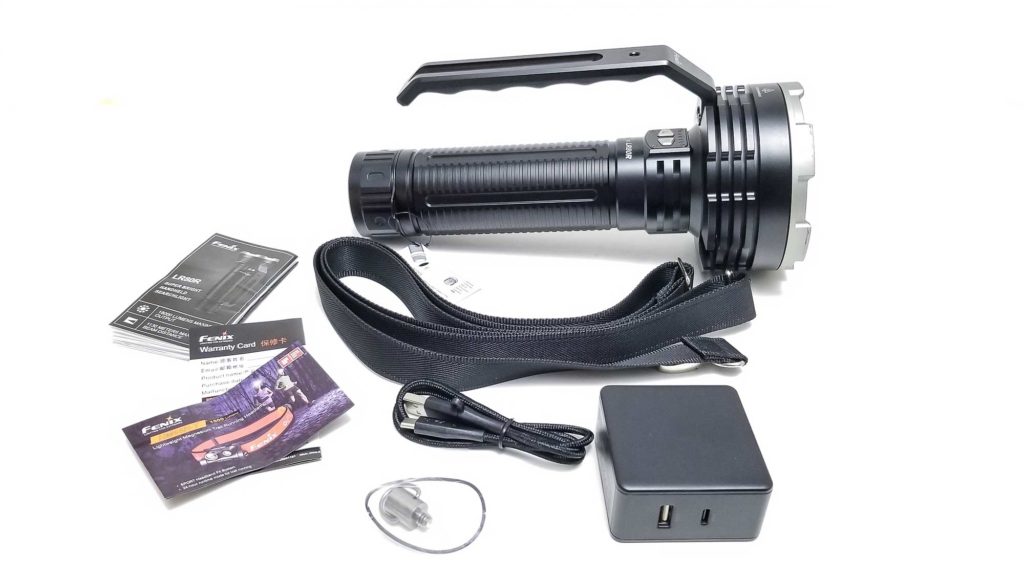
Flashlight in use
The Fenix LR80R is a searchlight, proficient at illuminating large areas at long range, perfect for search and rescue activities, surveying, or inspection. These lights have high capacity batteries and advanced electronics for long, regulated runtimes with constant brightness and thermal regulation. As a big, somewhat heavy light, the LR80R isn’t for casual use or EDC. It’s meant to be shoulder carried using the included strap, or carried by the detachable handle which is secured to the back of the head by two 5/32 cap head screws.
There are multiple mounting points for the handle as well: one at 12 o’clock, 7 o’clock, and 4 o’clock. The handle is interesting in that it’s solid aluminum and super sturdy (and long!) with finger grooves. It also has a ¼ inch threaded socket forward of the gripping surface for mounting to a tripod, or you can affix the included stainless steel adapter with swiveling bail, which can be affixed to a tripod or as an attachment point for a lanyard or the shoulder strap. At the rear there’s a tab that rotates freely for affixing the other end of the shoulder strap. The strap is pretty basic, with lobster claw clamps with swivels, but still effective and works fine.
There’s 2 e-switches directly behind the head under the handle marked L and H for the two mode groups. There’s a row of 5 LED indicators for battery state that light up when either switch is pressed, but do not illuminate when the light is on. Each switch controls a separate mode group for the UI, and they’re pretty typical e-switches, with a slightly mushy feel with slight clicks and feedback. They’d be fine for gloved hands.
For a light of this type, it’s relatively lightweight at a little over 3 lbs. Handling isn’t too cumbersome and it’s actually pretty well balanced and maneuverable. The diameter is comparable to a soda can light and has aggressive texturing with channels and grooves, and it’s very effective. The tail is wide and flat, so tail standing is possible, but be careful since its top-heavy nature can make it unstable.
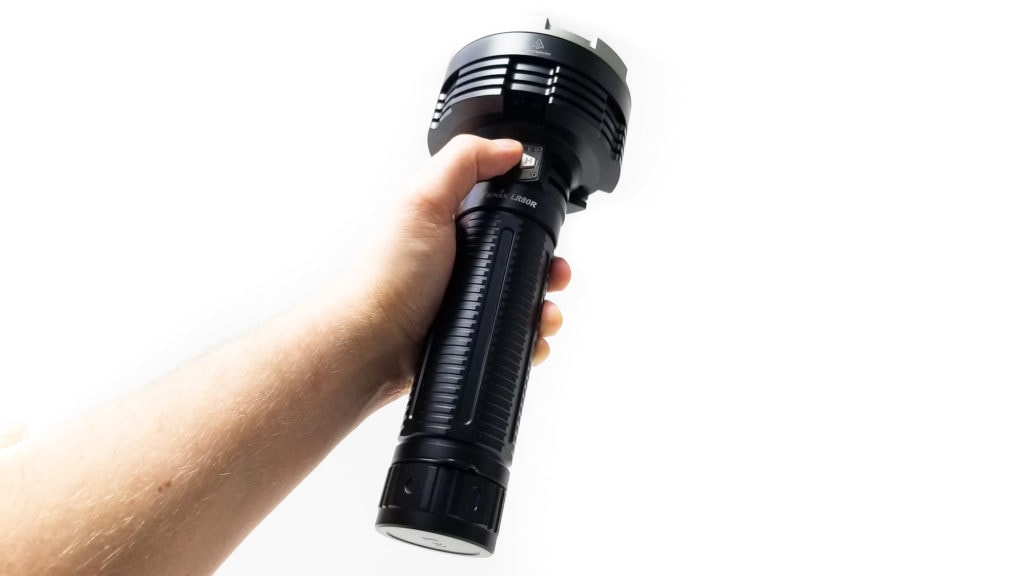
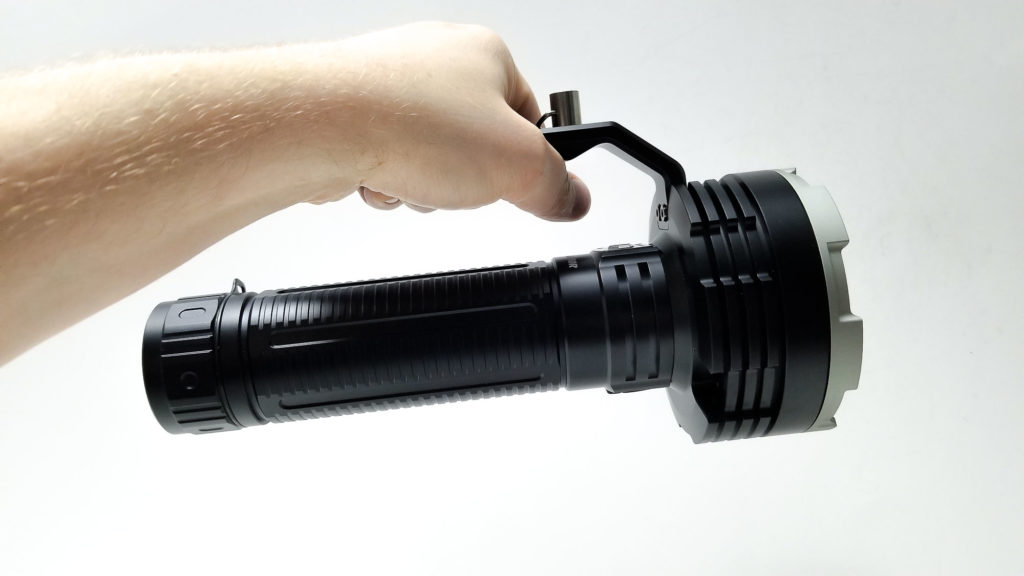
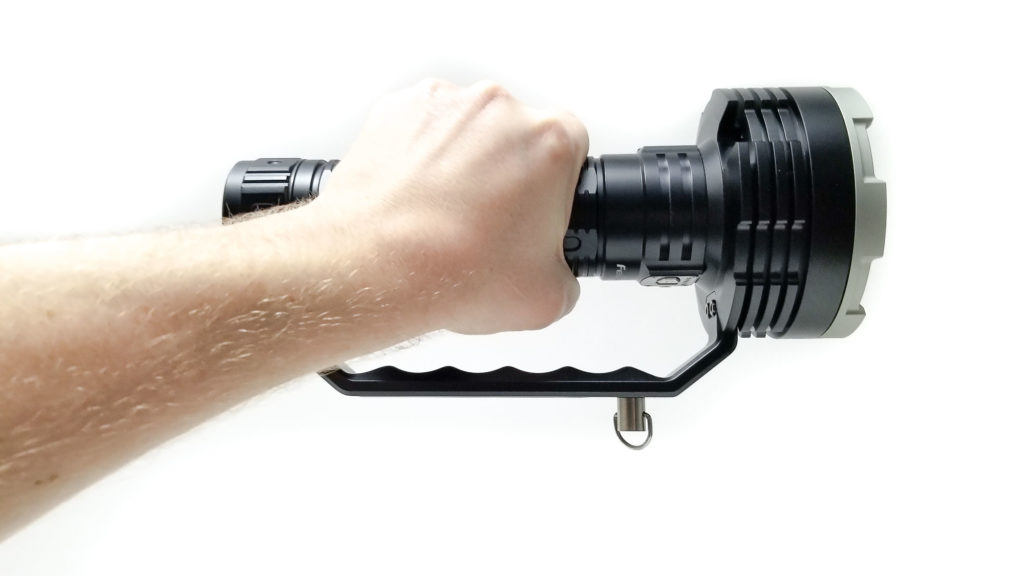
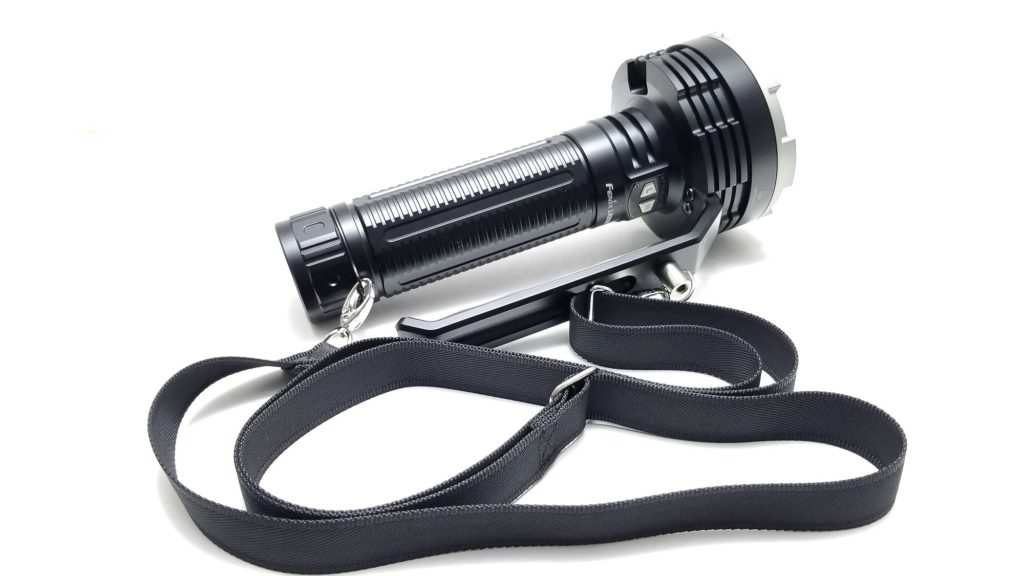
Build Quality, and Warranty
Every Fenix light I’ve reviewed has been top-notch with build quality, fit and finish. The LR80R is no exception. The build quality is excellent, and it should be since it sells for around $449. You might be thinking, “What? My Imalent MS06 has higher output for $150!” That’s true, but how long does it maintain that output? How about the throw? Runtime? It’s expensive for a reason, and you are getting a professional-grade light. Like with the A1, someone who needs this level of performance, quality, and reliability will pay extra for it.
The LR80R is milled from tough A6061-T6 aluminum, and for a light with a lot of machining area, the finishing is flawless: no tool marks, no chips, burrs, nothing anomalous. No issues with part fit-up either. The head has very deep heat sink fins up front, and thicker, shallower finning behind the head. The edges where your hands would touch (bezel included) are also chamfered and smoothed, but the rear heat sink fins had pretty abrupt edges that could benefit from chamfering. The finish is a type III HA anodizing, and like my other Fenix lights, it’s more glossy than matte, but still a very durable finish. My other Fenix lights have held up excellent even when riding in pockets with other lights, keys, and change.
Besides the carry handle, the light breaks down into two parts: the head and battery pack. The entire body of the light is the battery pack, and the threads are sturdy, precisely cut rectangular units. The pitch seems a bit slim, but they are fully anodized for manual lockout, and nicely lubed. They were oh so smooth out of the box, and never felt like they’d cross thread. The body took 3-¾ turns to fully seat. The head has 8 gold-plated, spring-loaded button contacts with a smaller spring-loaded center pin. These interface with 2 gold-plated circular contacts and a center contact on the battery pack for a low-resistance current path. There’s some philips screws and Torx screws that could be removed to poke around inside, but that would probably void the warranty. The body is sealed with a single o-ring, and the charge port cover creates a very nice seal as well. Fenix gives the LR80R a proper IP68 rating for 2 meters of submersion. This is an important metric since these lights need to work in all weather conditions.
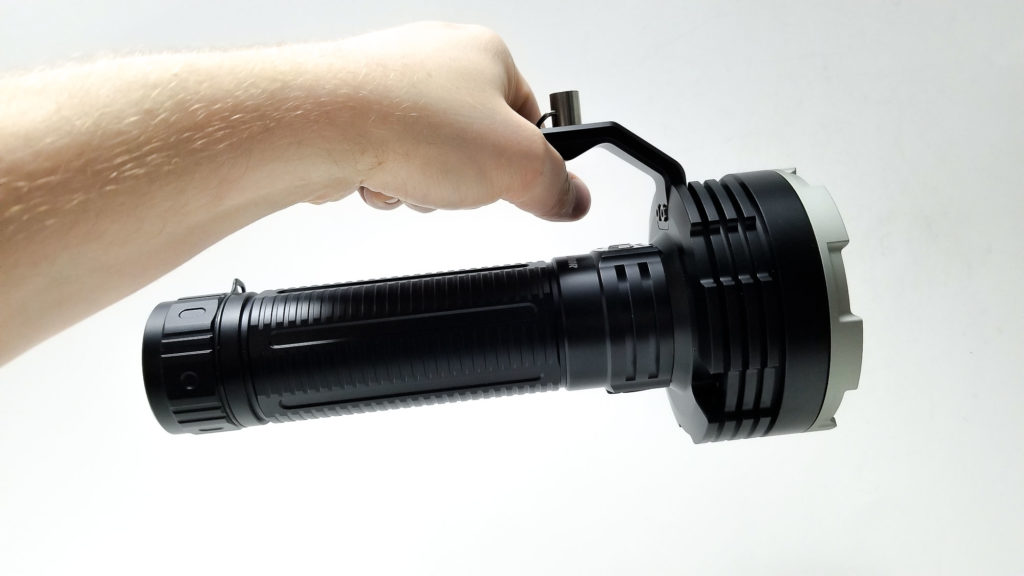
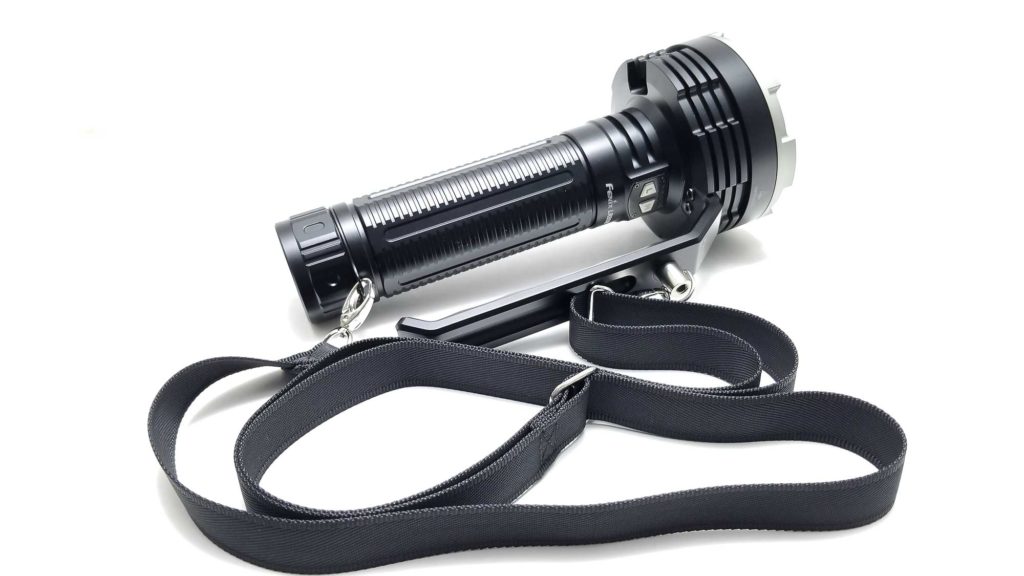
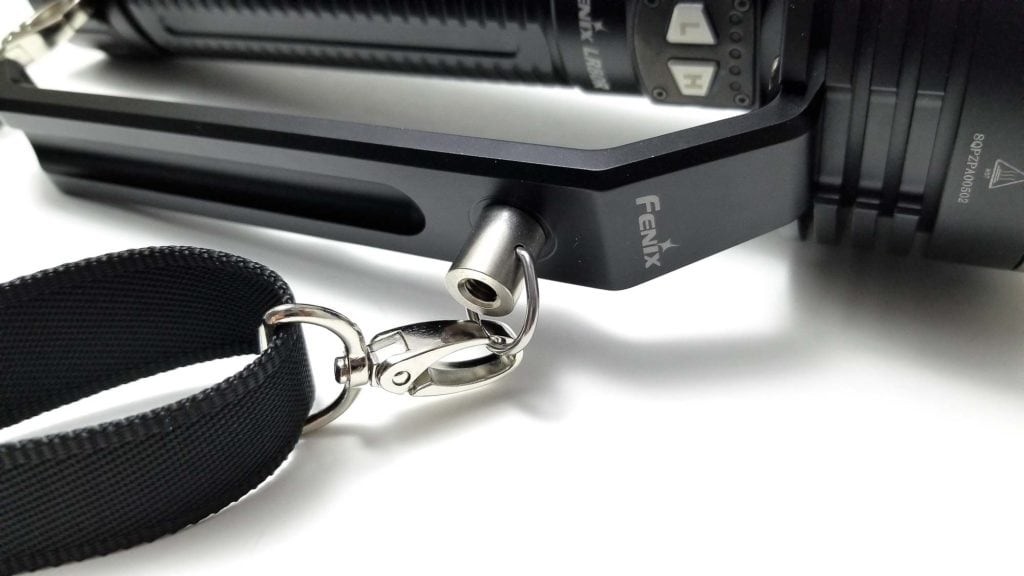

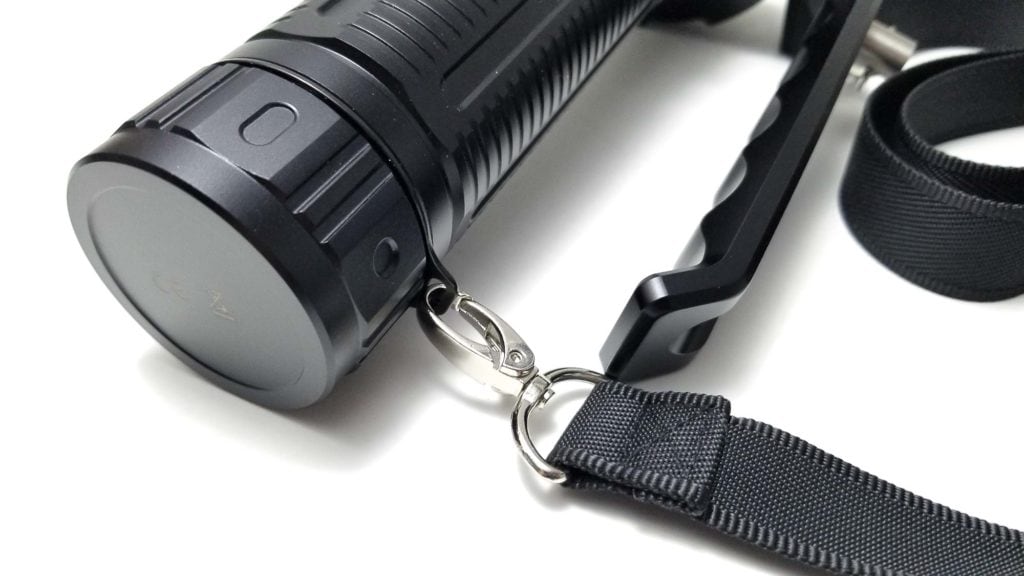
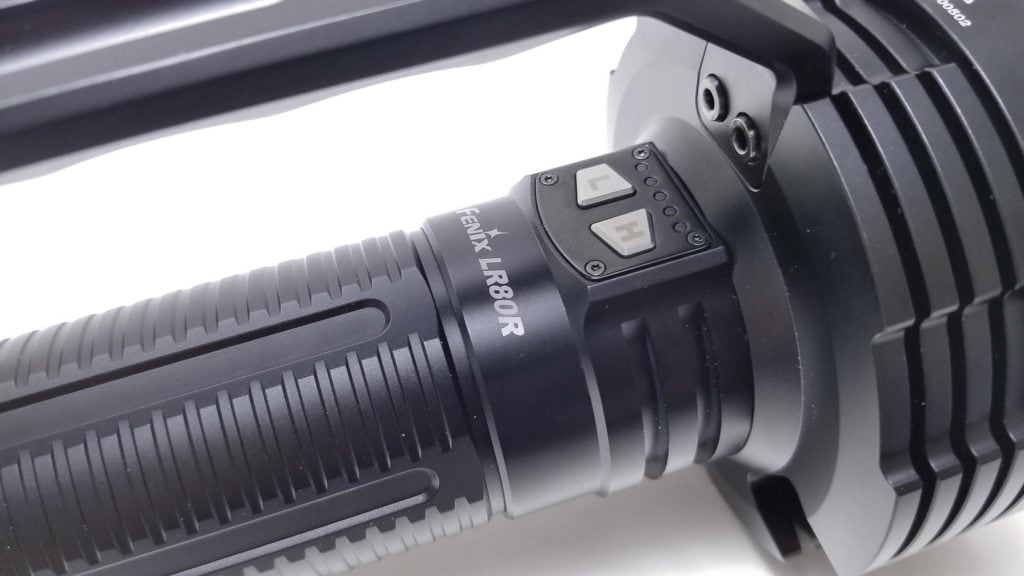
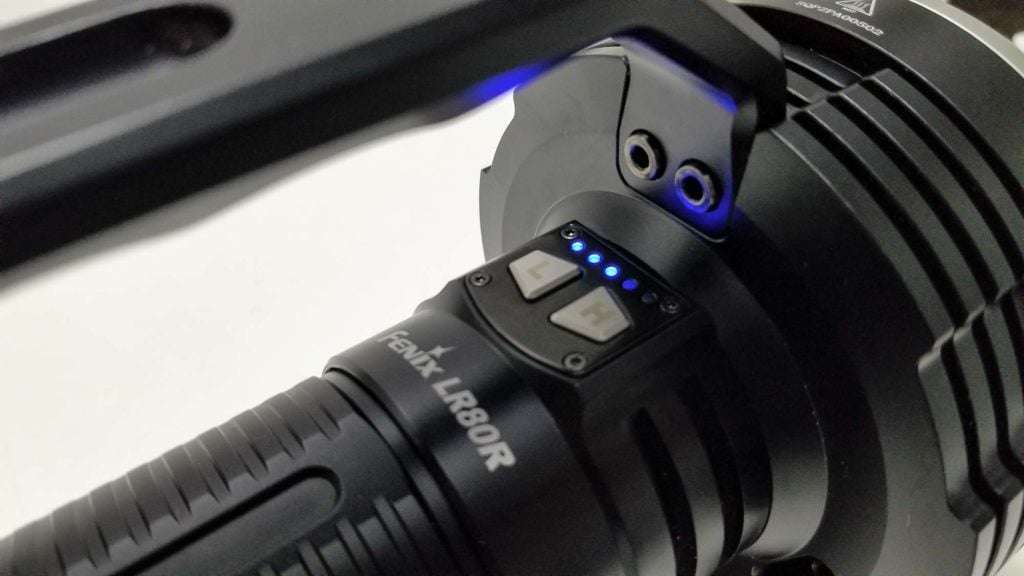
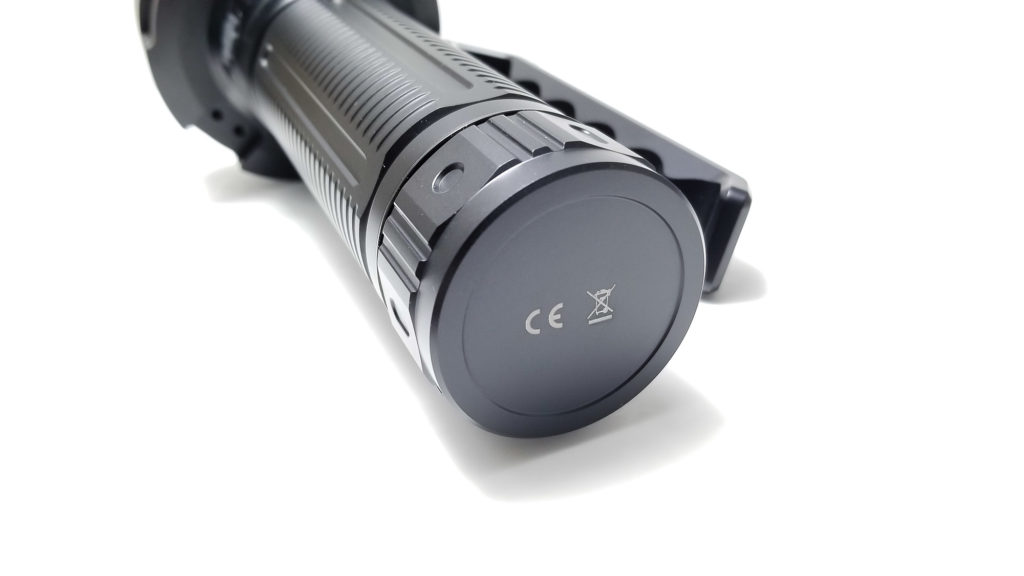
LED, Lens, Bezel, Beam, and Reflector
The LR-series lights use multiple emitters, and Fenix has always been forthright about the LEDs they use. Fenix seems to have an affinity for Luminus’ products, which are featured in many of their high output flashlights. The LR80R also utilizes Luminus LEDs, featuring 6 Luminus SST70s. This is a quad-die, 5050 footprint LED featuring 4 SST20 dies on a single substrate with a roughly 5.6 mm2 LES, or about 60% the size of an XHP50.2. This gives more throw and a much cleaner beam and tint uniformity. It only comes in CW though, so anywhere from 6000K to 6500K for the CCT, which is totally fine for the LR80R (and just about any working light). These are wired up for 6 or 12 volt operation, so the drive currents are lower.
The bezel is a crenulated, very sturdy sandblasted stainless unit. It’s flawless, chamfered, and fits perfectly to the head. The lens is a toughened mineral glass unit with dual AR coating. It’s recessed about 6 mm under the bezel, with the crenulations adding considerable drop protection. At the 6 o’clock position on the face of the reflector, there’s 2 sensors. These are the proximity sensors that detect when an object is 60 mm away and automatically decreases the output to prevent damage.
The reflector is a 6 cup design, with SMO reflector cups arranged in a radial pattern. This gives a ton of bright spill with a defined hotspot. It’s tuned well to the SST70s, and throws very well with plenty of reach. Overall this is an excellent multipurpose beam with even tint distribution, no corona, and although it has artifacts, they’re minimal. The tint, while skewed a bit green at low output, turns bright white at higher output. The Opple Lightmaster shows 6512K at 67.7 RA on the highest setting at about 3 meters from the source for a duv of 0.0050.
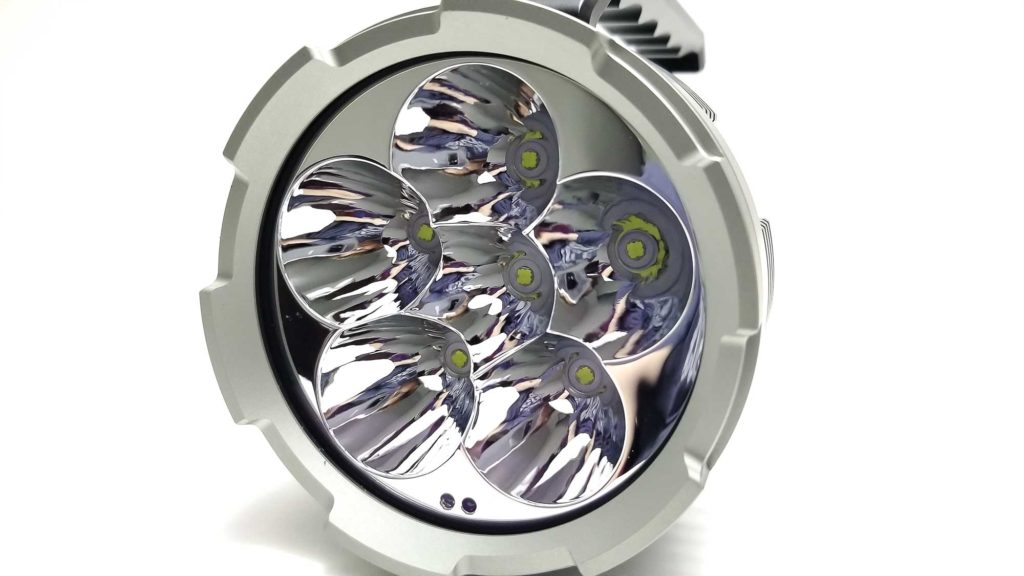
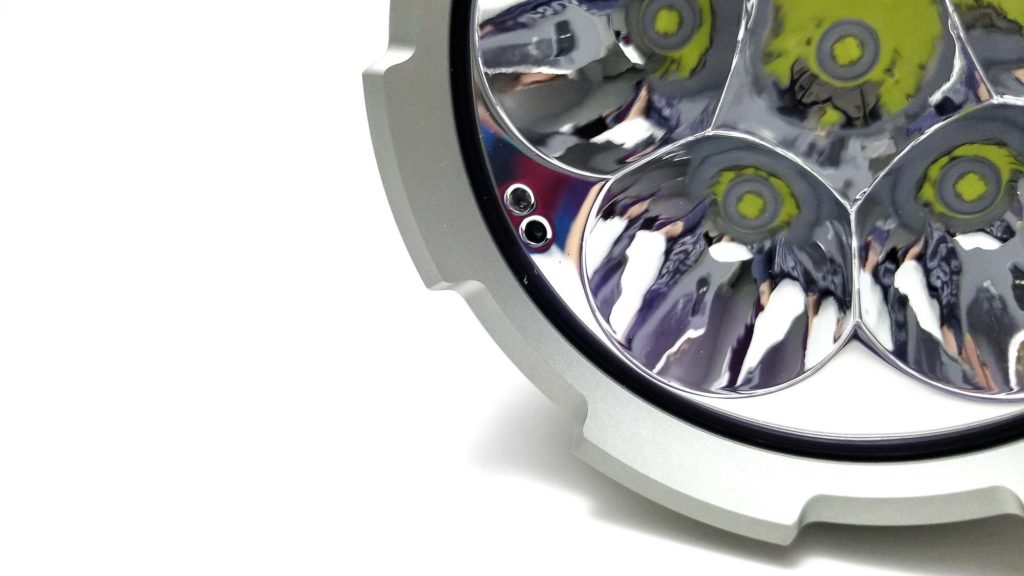
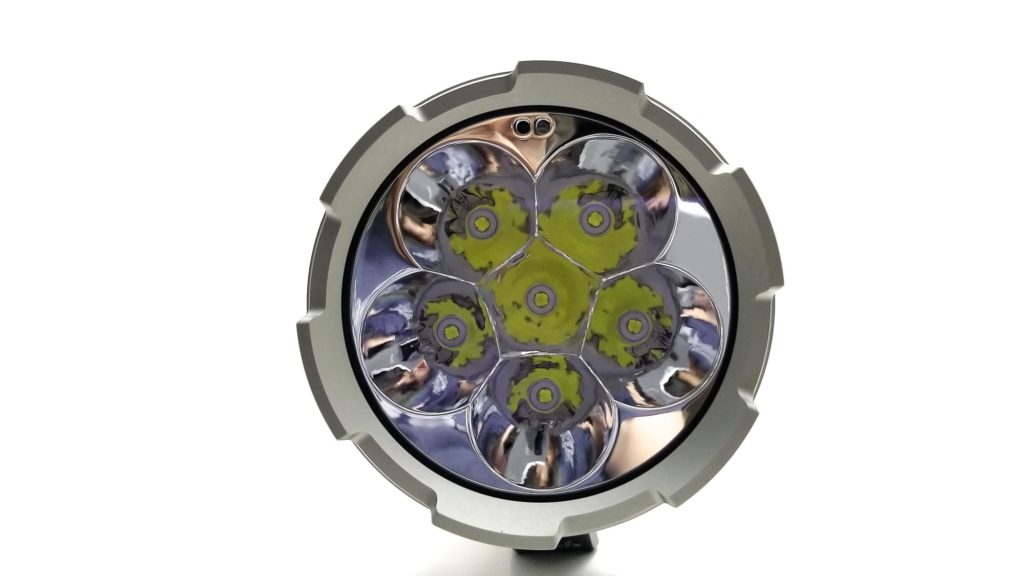
Dimensions and size comparison
Length:
- Length: 259 mm / 8.46 inches
- Head diameter:108 mm / 4.25 inches
- Body diameter: 54 mm / 2.13 inches
Weight:
- Total with battery+handle:1653 grams / 1.65 kg / 3.64 lbs
- Head+handle: 869 grams / 30.6 oz
- Head without handle:735 grams / 25.9 oz
Flashlight size comparison with its competition
I compared the LR80R to some very powerful lights:
Group 1 left to right: Wuben A1, Fenix LR80R
Group 2 left to right: Wurkkos DL70, Fenix LR80R, Thrunite TN50, Astrolux FT02S
Group 3: Fenix LR80R, Thorfire C8
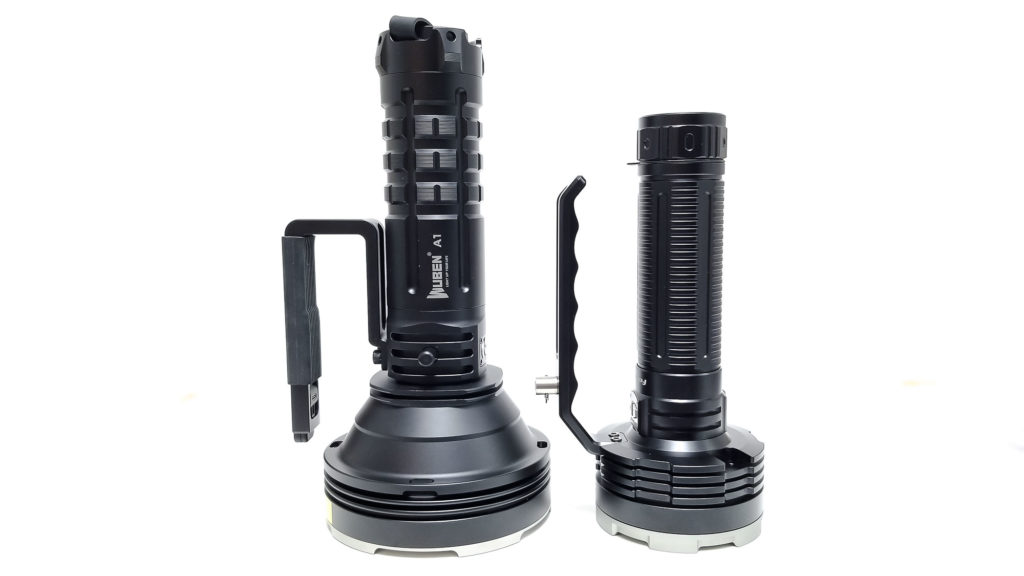
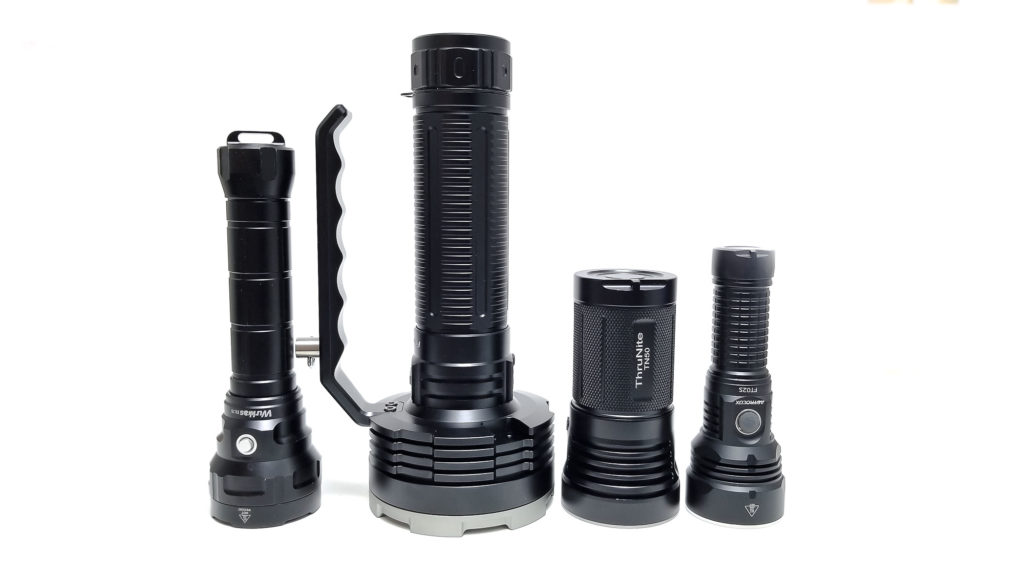
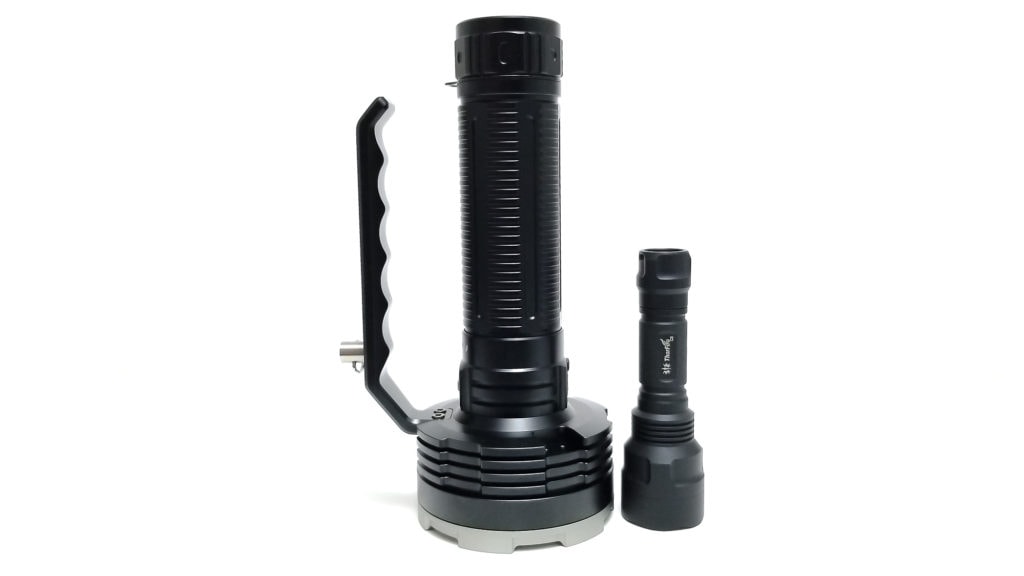
Fenix LR80R User Interface & Driver:
The LR80R features a constant current driver, probably a buck driver since the battery is 8.4 volts fully charged. These drivers deliver fully regulated output, so no dimming as the battery voltage decreases. This is essential for consistent output during long-duration operation.
The UI is tailored around the dual switches, with each switch controlling an independent mode group: The ‘L’ marked switch, which Fenix calls the auxiliary switch, controls lower output modes and the ‘H’ switch, or main switch, controls high output modes. These groups can operate independently of each other, which is a nice feature and adds a lot of versatility. Each group has 5 modes, with subtle differences. Turbo is not available in Low Output mode, but Strobe and S.O.S are. Conversely, the blinkies are not part of the High Output mode.
Available modes:
Low Output Mode Group: Eco, Low, Medium, High, Strobe, S.O.S.
High Output Mode Group: Low, Medium, High, Turbo
From OFF:
- Single click either switch: Shows battery state
- Press and hold either switch: Turns on in last mode
- Press and hold Low Output switch for more than 3 seconds: Variable Strobe. Pressing again switches to S.O.S.
- Press and hold both switches for 5 seconds: Electronic lockout
From ON:
- Single click switches: Change modes
- Press and hold switches: Turns off
- Press and hold Low Output switch for 3 seconds: Strobe. Pressing again advances to S.O.S.
Mode memory
- Yes, even remembers Turbo, but not Strobe or S.O.S
Shortcuts:
- Long pressing the High Output switch activates Turbo
- Long pressing the Low Output switch activates Strobe or S.O.S.
Low voltage warning:
- Yes. When the battery gets low, the output will decrease gradually until Low mode in the High Output group. In the Low Output group, the brightness will gradually step down to Eco mode. The 5 LEDs above the switches show battery state. Five blue lights on: 100% – 80%, four blue lights on: 80% – 60%, three lights: 60% – 40%, two light: 40% – 20%, one light: 20% – 0
Strobe/blinkies
- Strobe, S.O.S. (only in Low Output mode)
Lock-out mode:
- Yes. Press and hold both switches for 5 seconds. The light will blink twice in Low.
PWM
- None
Additional info on the UI:
- Once again, Fenix delivers a very simple, but effective UI. The dual switches are nicely implemented and I like the discrete mode groups with different outputs. Turbo is definitely the brightest, and the Low setting on the Low Output is the least. In fact, on the Low mode in the Low Output group, only the center LED in the reflector is lit. Switching to Medium switches the rest on, so this is a multi-channel driver. Fenix includes all the functional enhancements like temperature regulation, with timed and regulated step downs, set to kick in at 60 C. There’s also the aforementioned proximity sensor that steps the output down after 1.5 seconds to Eco mode if in any mode higher than Low. This prevents non reflective or dark items from burning or melting if the light is too close. It’s a nice safety feature for sure, but I think it’s set a bit too aggressively, since only High and Turbo could potentially burn stuff.
Batteries & Charging
Like other high output professional use lights, the LR80R utilizes a battery pack. The battery is made up of 21700 cells. Although Fenix doesn’t say how many or what capacity they are, since the battery is 8.4 volts and 12,000 mAh, it’s safe to assume this is a 2S3P battery arrangement of six, 4000 mAh 21700s. It’s going to have a BMS board with all the requisite safety features (under and over discharge, overtemperature, and short circuit protection) to help keep the light and the user safe, and ensure long-lasting performance. The batteries aren’t removable from the pack per Fenix, so when the battery goes flat, you send it back for replacement. That’s the only downside of this type of battery setup, but again, the battery should last a while, and it’s commonplace for lights of this type (and price).
For charging, the LR80R uses a USB type C PD input rated for up to 45 watts of power, which is a lot, and should charge the battery in about 4 hours. The included charger is a high quality one with a USB type C output for PD, and a 2.4 A USB type A output. I charged the mostly-full battery and got 15 volts 2.5 amps, for 37 watts on my USB tester. During charging, the LED indicators above the switch flash, moving from left to right. There’s also a power bank functionality via a USB type A output located under the type C input. Fenix doesn’t specify any output specs, but my USB meter showed 5 V 2A When using the power bank, the indicator LEDs move in the opposite direction, from right to left. I really like the included USB cable since some other lights don’t include one that works with both charging and the power bank.
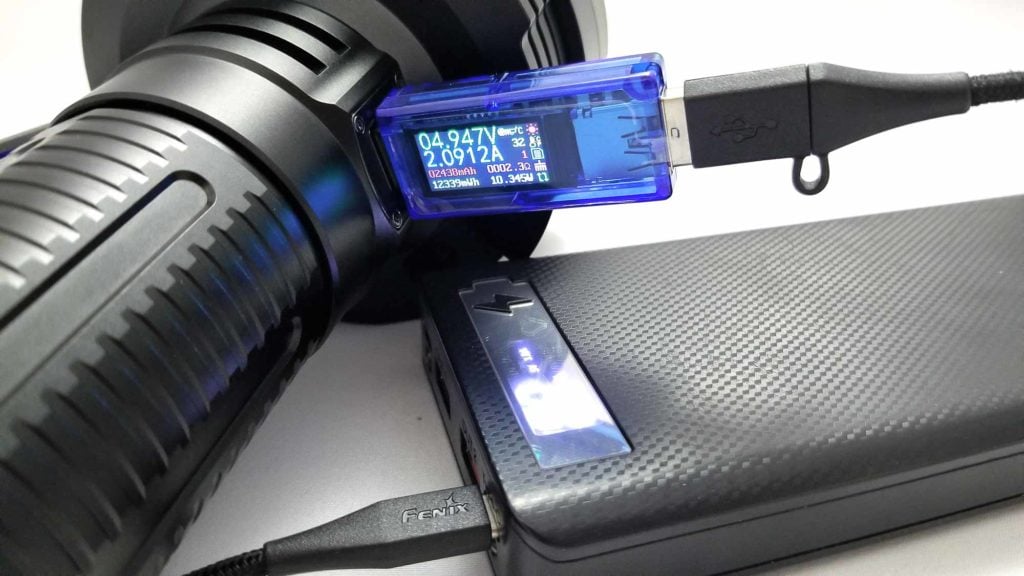
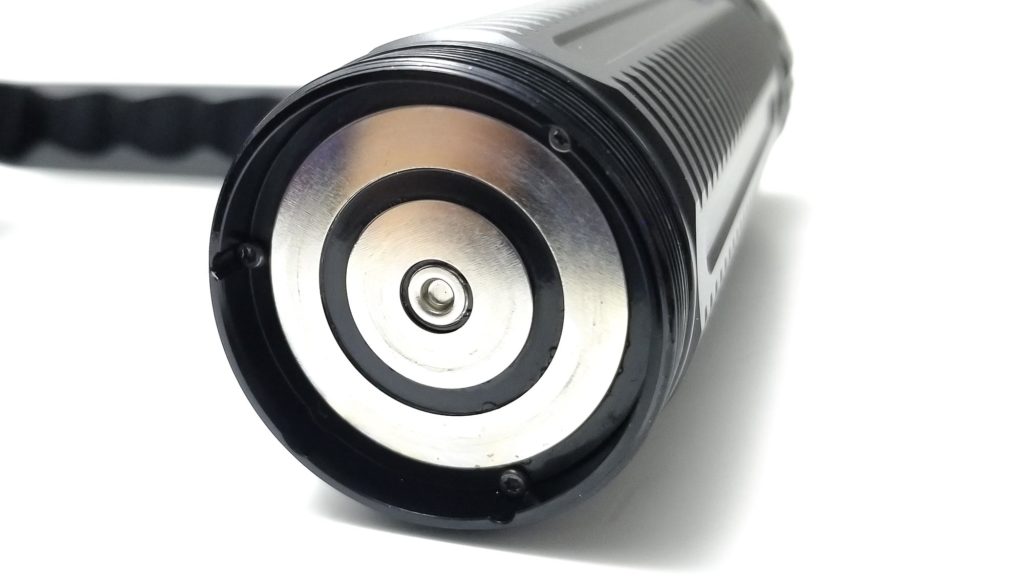
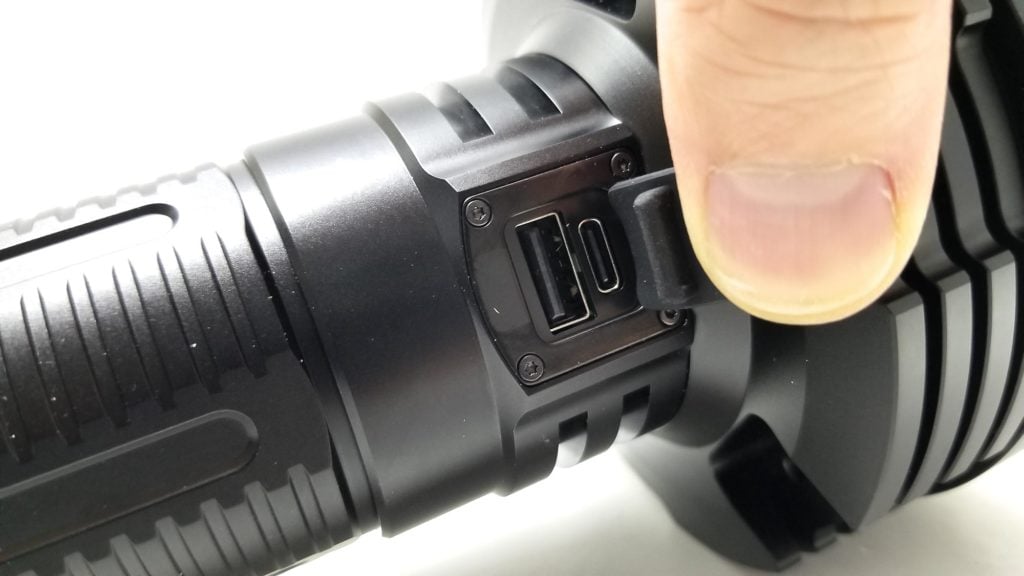
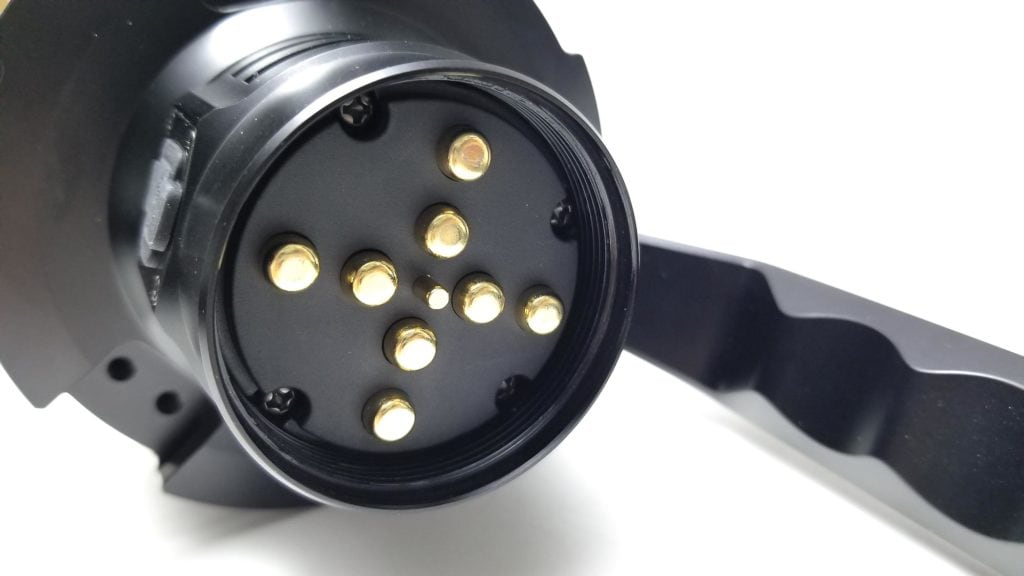
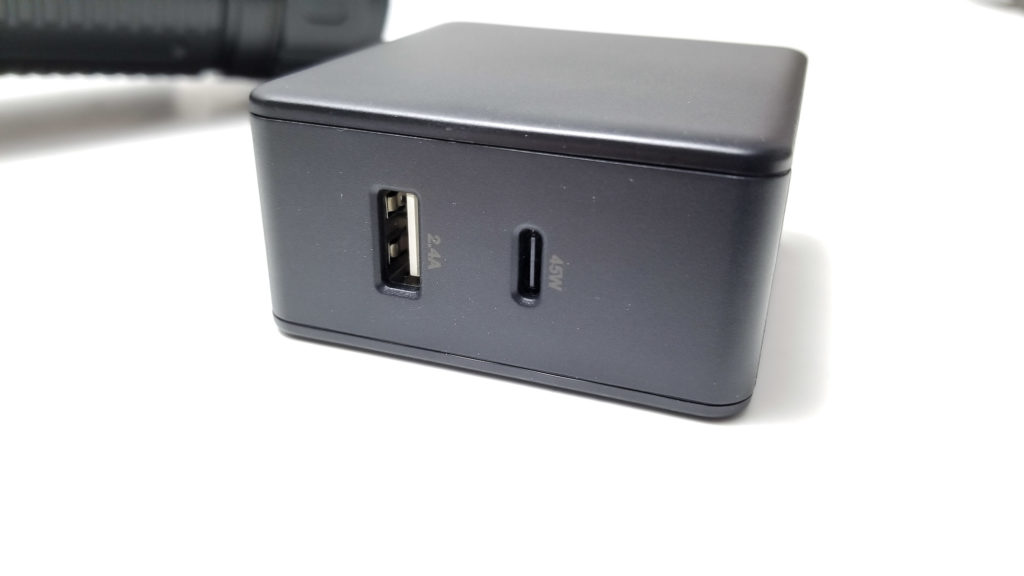
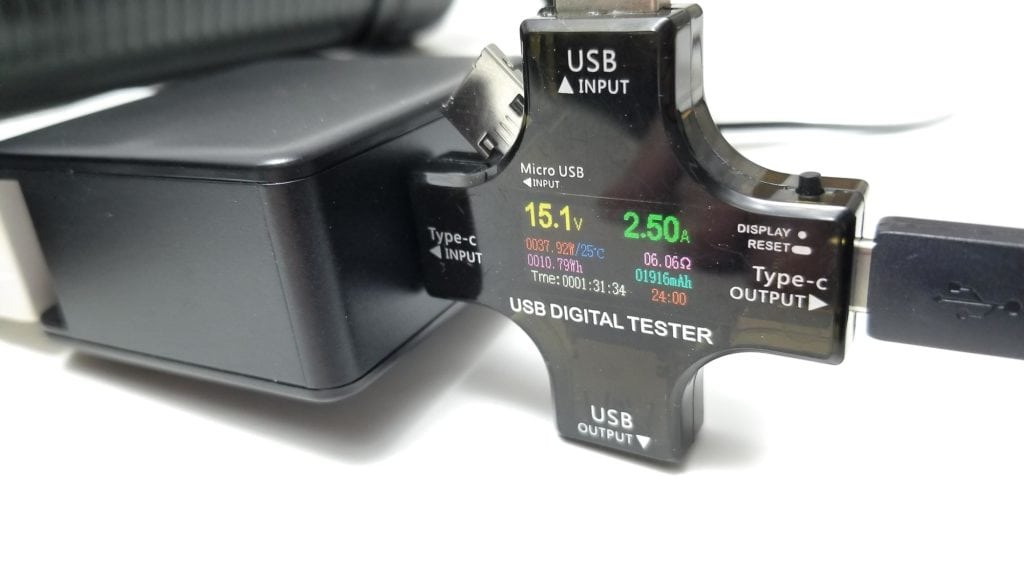
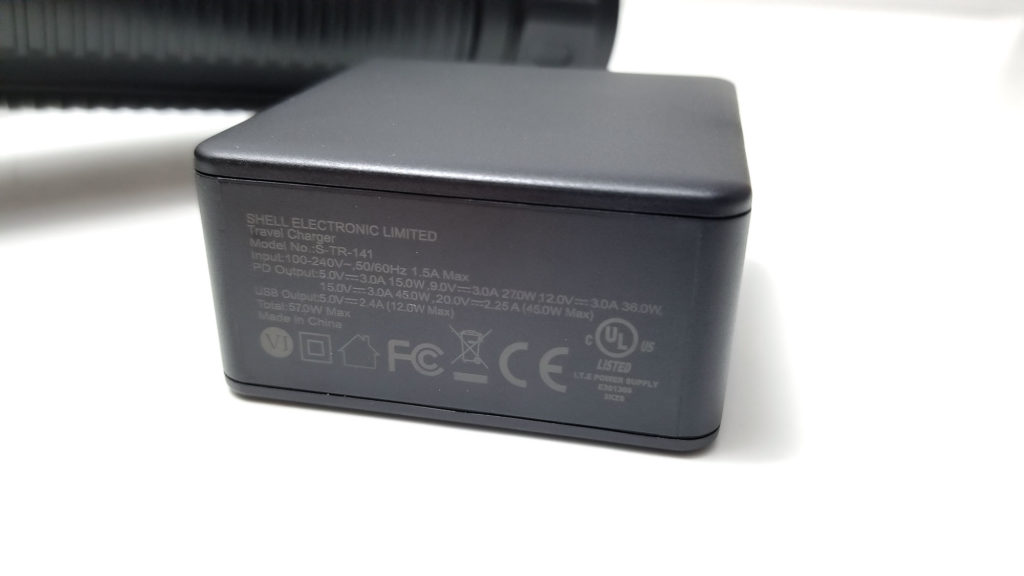
Fenix LR80R Performance test
Lumen measurements
Lumens are measured using my home made 50 cm integrating sphere which has been calibrated with many lights of known outputI I use a Digi-Sense 20250-00 datalogging luxmeter. No current measurements due to the interesting current path. Expect these figures to be accurate within 10%.
| Low Output Mode | Specs | turn on | 30 sec | 10 minutes |
|---|---|---|---|---|
| Eco | 50 | 44.8 | 44.8 lm | – |
| Low | 150 | 146 lm | 146 lm | – |
| Med | 450 | 426 lm | 426 lm | – |
| High | 1,000 | 924 lm | 924 lm | – |
| High Output Mode | Specs | @turn on | @30 sec | @10 minutes |
| Low | 3,000 | 2940 lm | 2940 lm | – |
| Medium | 6,000 | 6400 lm | 6400 lm | 6240 lm |
| High | 12,000 | 12,600 lm | 12,320 lm | 6440 lm |
| Turbo | 18,000 | 19,071 lm | 17,604 lm | 5379 lm |
Parasitic drain:
- N/A
Runtime graph
I tested the runtimes in my home-made 50 cm integrating sphere using the Digi-Sense 20250-00 datalogging luxmeter. The sphere has been calibrated with lights of known output. I tested Medium, High, and Turbo in the High Output group. I used the fully charged battery pack for each test.
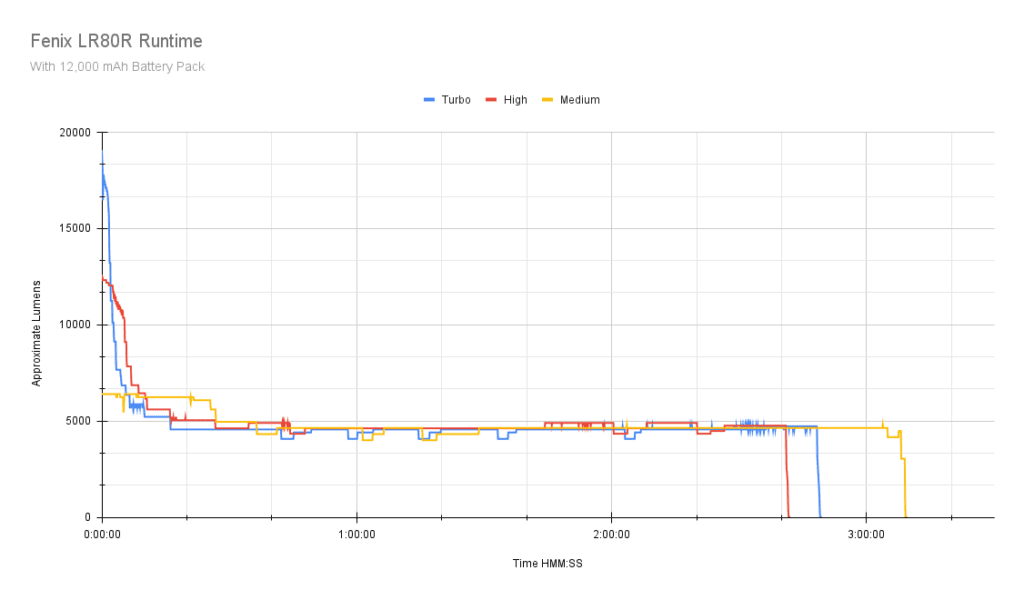
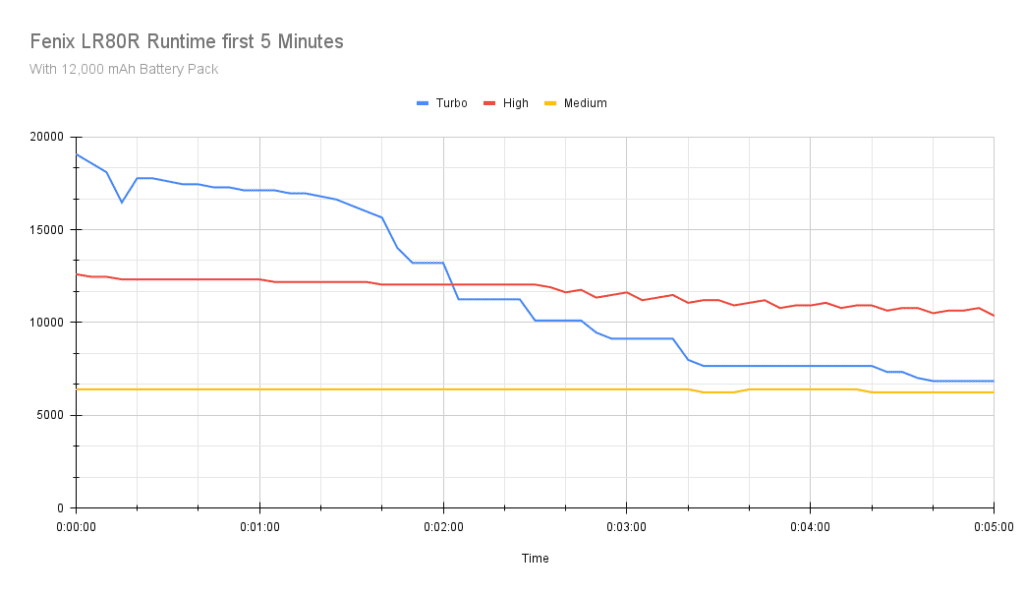
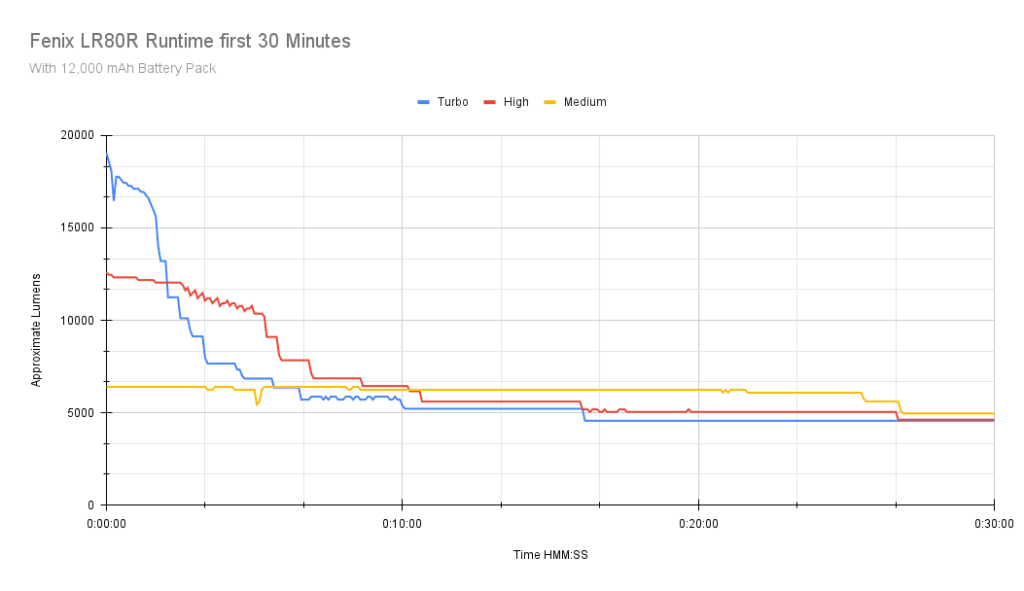
I did have an issue with the first LR80R. When I ran the Turbo test, there was a malfunction with the thermal control and the light did not reduce the output. The temperature rose to 120 C. It wasn’t until 8 minutes of 90-120 C temperatures that the thermal control kicked in, but it was too little too late. Turns out, the reflector is plastic, and the coating on the base of the reflector cups bubbled and warped from the heat, but the LR80R soldiered on and still worked fine. Fenix stepped up and sent out a replacement LR80R and I finished the Turbo test. Thanks Fenix!
Turbo started at 19,071 Lumens and started stepping down after 5 seconds, but maintained over 17,000 Lumens for over 60 seconds, and better than 10,000 for almost 3 minutes before slowly ramping down to 5216 Lumens by 10 minutes in. It maintained that output for about 6 minutes, with gradual drops in output, but maintained over 4000 Lumens for the next 2 hours 28 minutes until LVP drops the output to Eco mode and I ended the test at 2 hours 49 minutes. Fenix runtime spec is 2 hours for this mode. The temperature regulation kept the light from melting itself this time, with the output stepping down when the head hit 56 C, and thermo regulating to a max of 60 C by 10 minutes in. The temperature rose pretty quickly, hitting 50 C by 40 seconds in, and 58 C by 120 seconds.
High started at 12,600 Lumens and it maintained better than 12,000 Lumens for 2 minutes 30 seconds with a slight drop to 11,900 Lumens. The output was still over 10,000 Lumens by 5 minutes 20 seconds, and better than 5000 for the next 21 minutes. The output settled between 4200 and 4900 Lumens for the next 2 hours. The output dropped suddenly at 2 hours 41 minutes, and the light shut off 40 seconds later. The thermal ceiling was 55.8 C for this test, and it took 10 minutes from an ambient 28.5 C to reach. Fenix runtime spec is 2 hours 15 minutes.
Medium was very consistent like the other modes, starting at 6400 Lumens and held better than 6000 Lumens for 25 minutes, with gradual step downs until leveling off at 4600 Lumens by 41 minutes in. It held this output for the next 2 hours 12 minutes when the output dropped to 3000 Lumens, with a deep drop before shutdown at 3 hours 9 minutes. It did heat up to 55 C by 30 minutes in,, but it heated slowly. Fenix runtime spec for this mode is 2 hours 50 minutes.
This is pretty fantastic performance and about what I expect from a constant-current regulated driver and a professional-grade flashlight. The output is nice and laminar, with proper thermal regulation on all the High Output modes. There is some oscillation as the light regulates the brightness, but it’s pretty much invisible in real-world use and it keeps the light cool enough to use without the handle. It seems like Fenix nailed the driver/LED configuration to make the most of the SST70.
Throw numbers:
Throw was measured using the Uni-T 383S luxmeter at 5 meters indoors. Readings taken at 30 seconds. The battery pack was fully charged for the tests.
| Low Output Mode | Specs | Candela measured | Meters | Yards |
|---|---|---|---|---|
| Eco | 590 cd | 625 cd | 50 | 54.6 |
| Low | 2700 cd | 3100 cd | 111.35 | 121.77 |
| Medium | 7750 cd | 8025 cd | 179.16 | 195.93 |
| High | 17,750 cd | 18,475 cd | 271.84 | 297.28 |
| High Output Mode | Specs | Candela Measured | Meters | Yards |
| Low | 54,000 cd | 58,300 cd | 482.9 | 528.10 |
| Medium | 10,5000 cd | 117,125 cd | 684.47 | 748.54 |
| High | 211,700 cd | 242,250 cd | 984.37 | 1076.52 |
| Turbo | 318,000 cd | 326,000 cd | 1141.92 | 1248.81 |
I usually measure 1000+ meter throwers at 10 meters outdoors, but since the beam convergence would be optimal at 5 or 10 meters, I opted for the shorter distance. Even so, my 5 meter figures are within 60 meters of Fenix advertised, and tons of throw on Turbo and High modes.
Extra info: Peak beam distance according to ANSI FL1 standards: The calculated value of distance in meters at which the flashlight produce a light intensity of 0.25 lux. (0.25 lux is about the brightness of a full moon shining on an object).
Beamshots
I ran the LR80R alongside the brightest lights I own: The Thrunite TN50, Nightwatch NI03 Valkyrie, Wurkkos DL70, Astrolux MF01 Mini, and Imalent R30C. I also tested it against the crazy Wuben A1 and equally crazy Nightwatch NS59v1.
The fence is about 40 m away. You can see the differences in beam profiles and throw distance pretty well.
The tower is about 950 meters away. The LR80R doesn’t quite reach it (but the Wuben A1 sure does!)
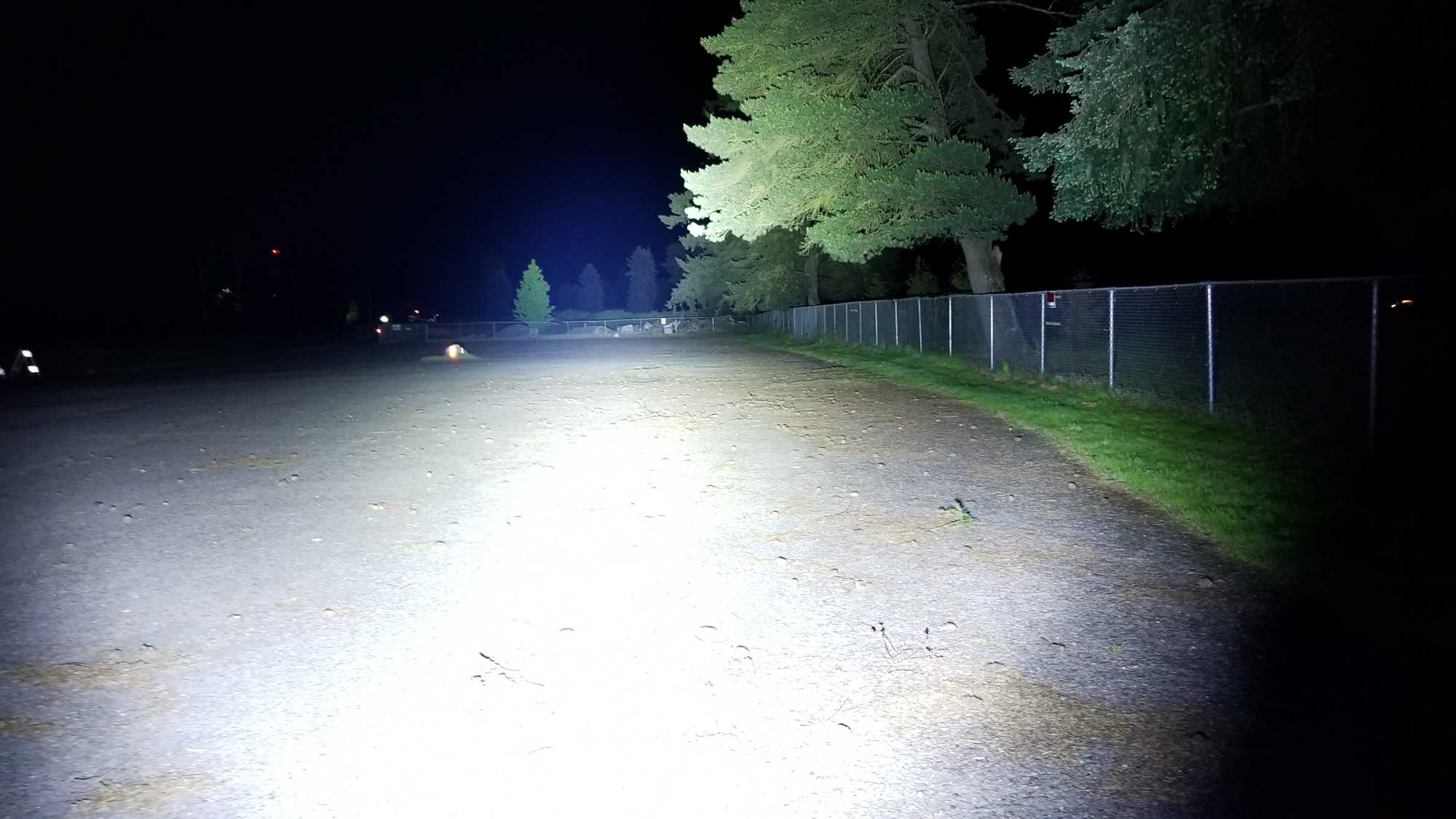
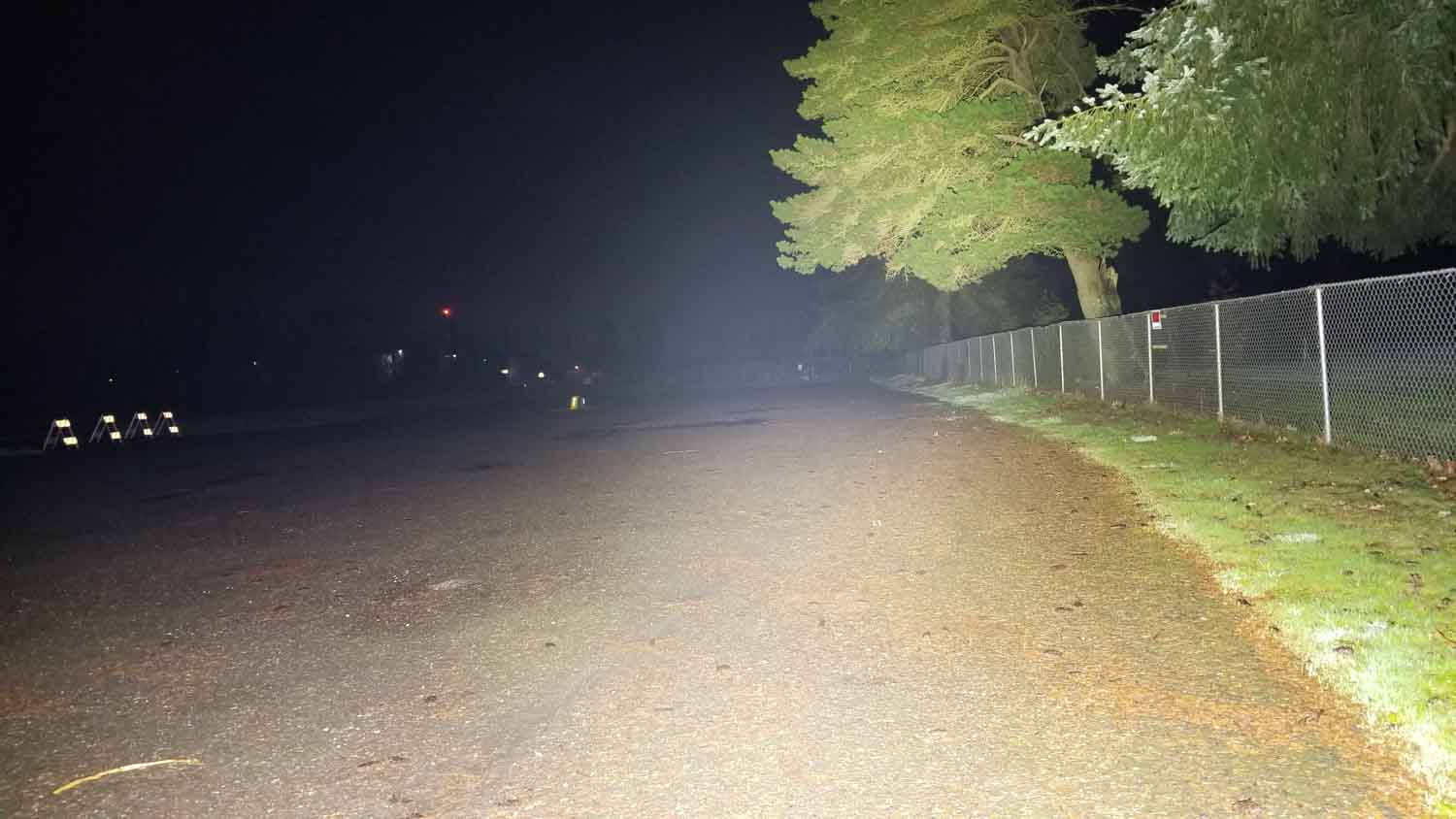
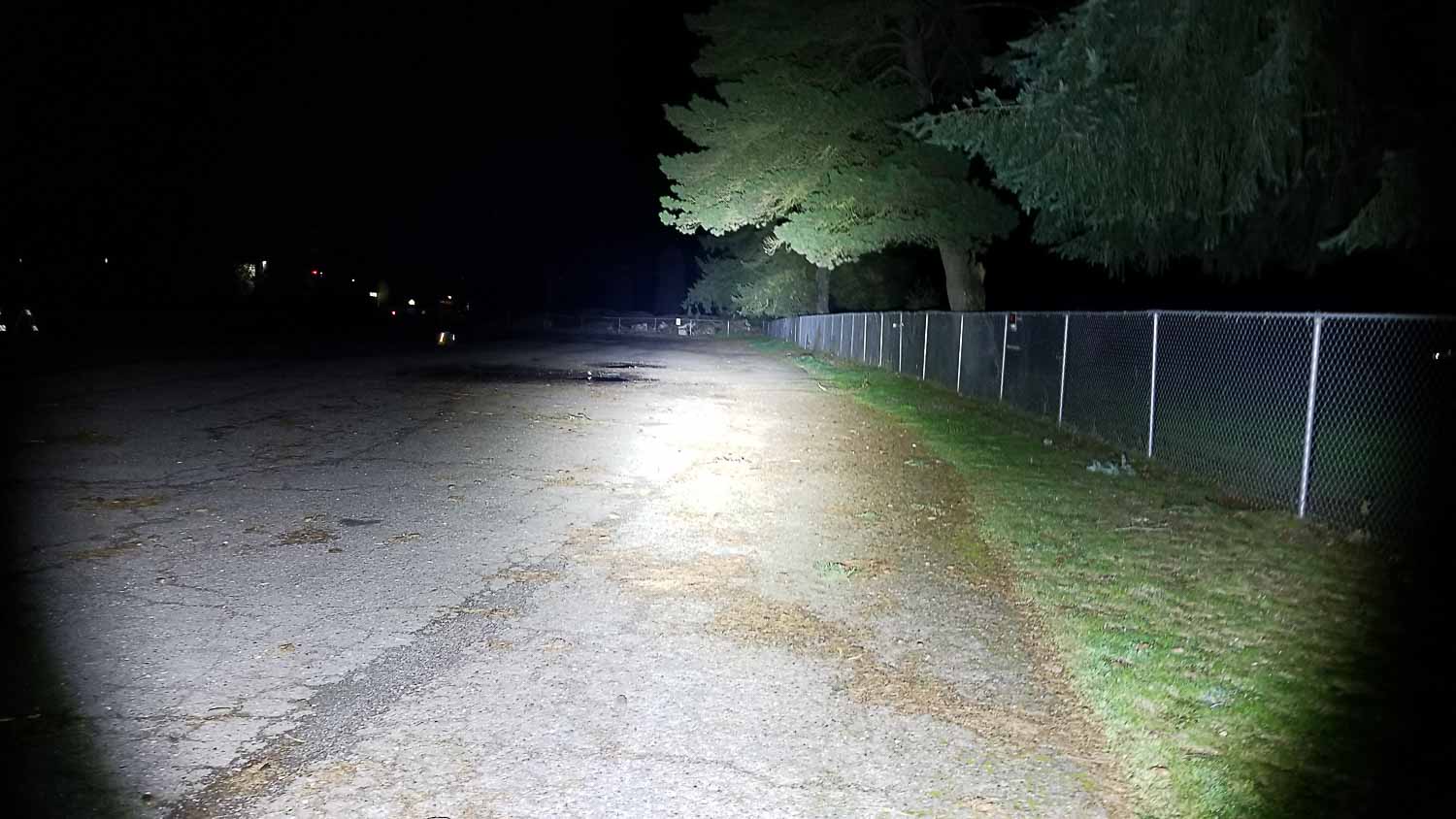
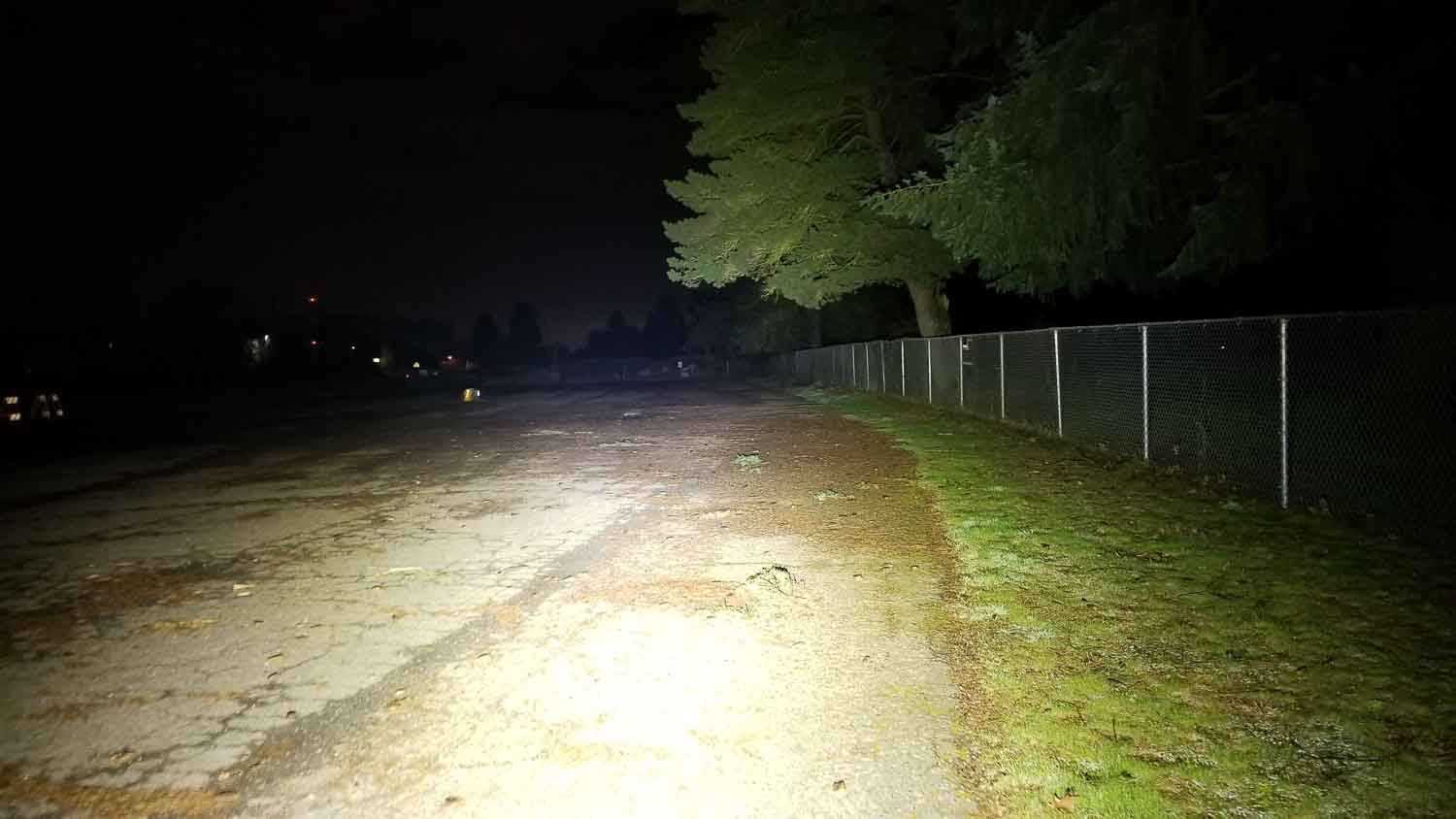
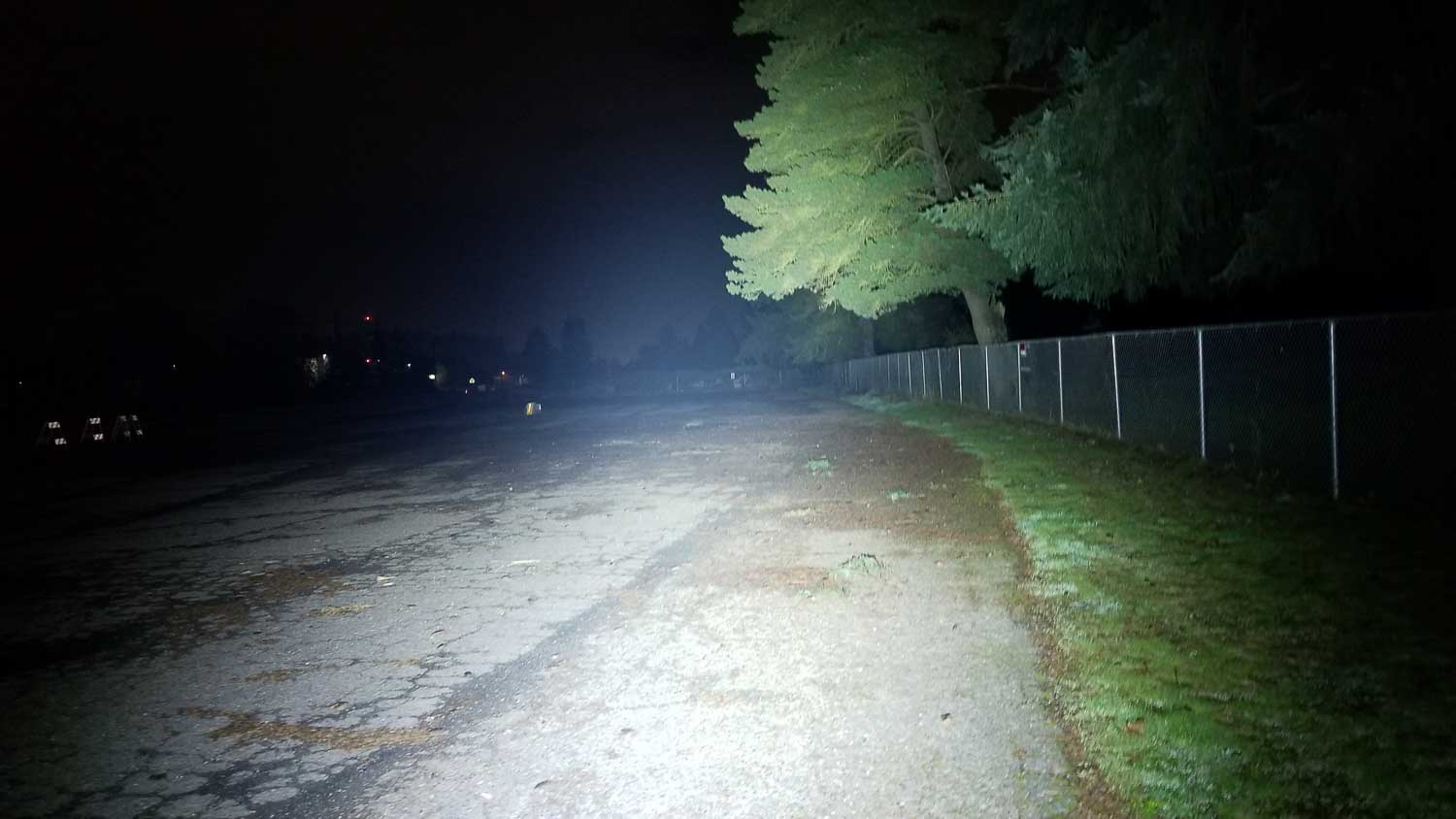
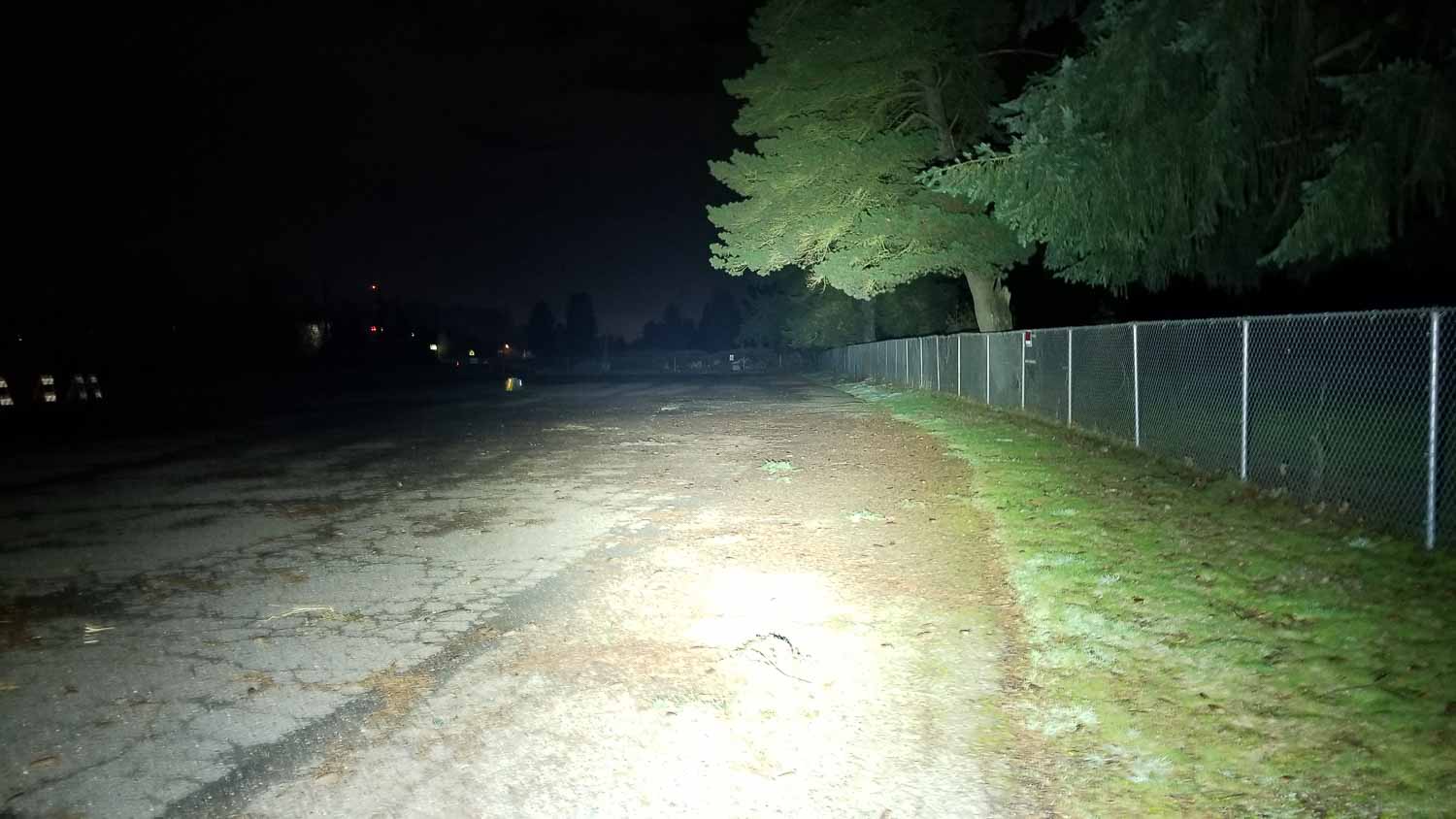
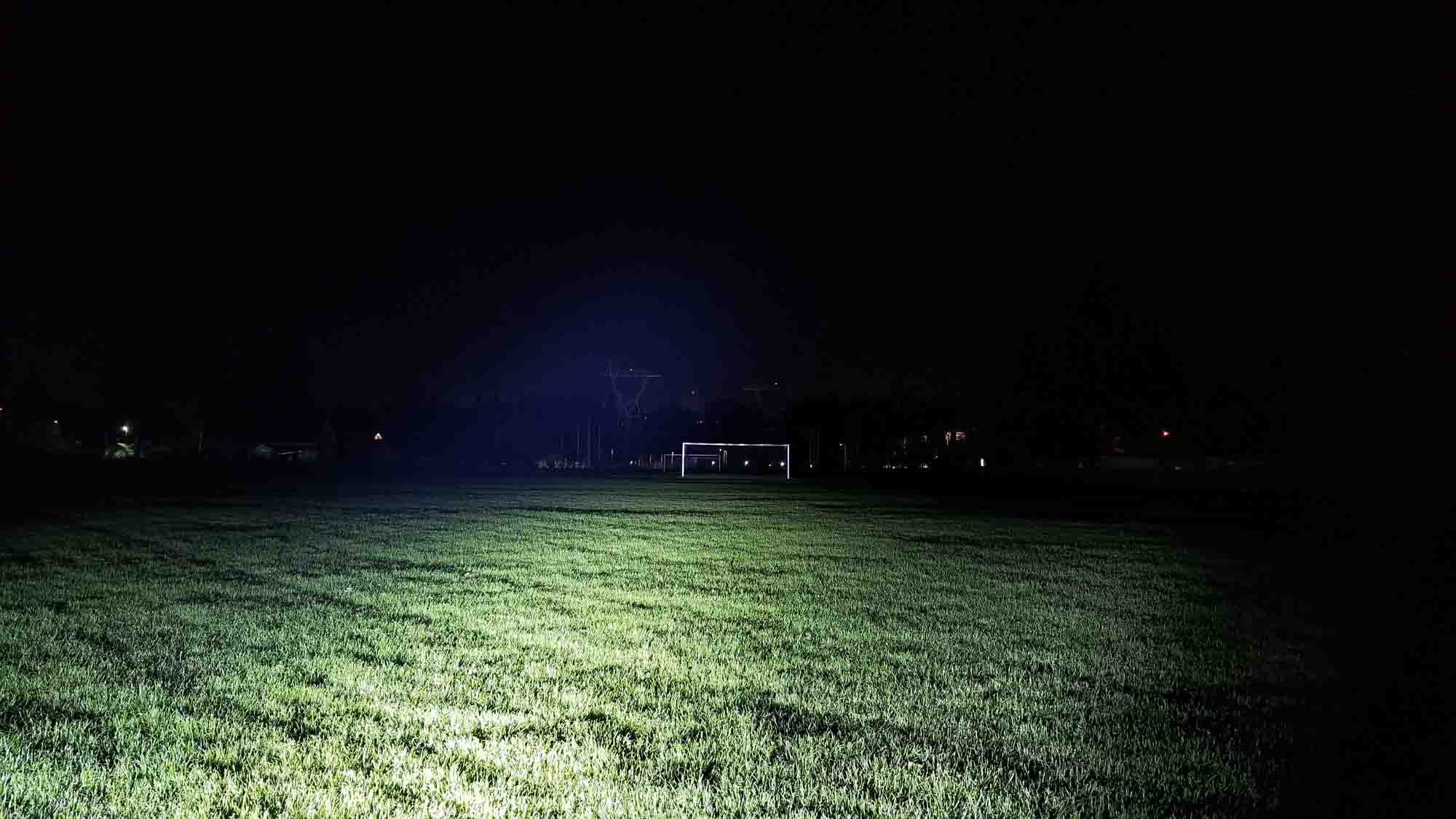
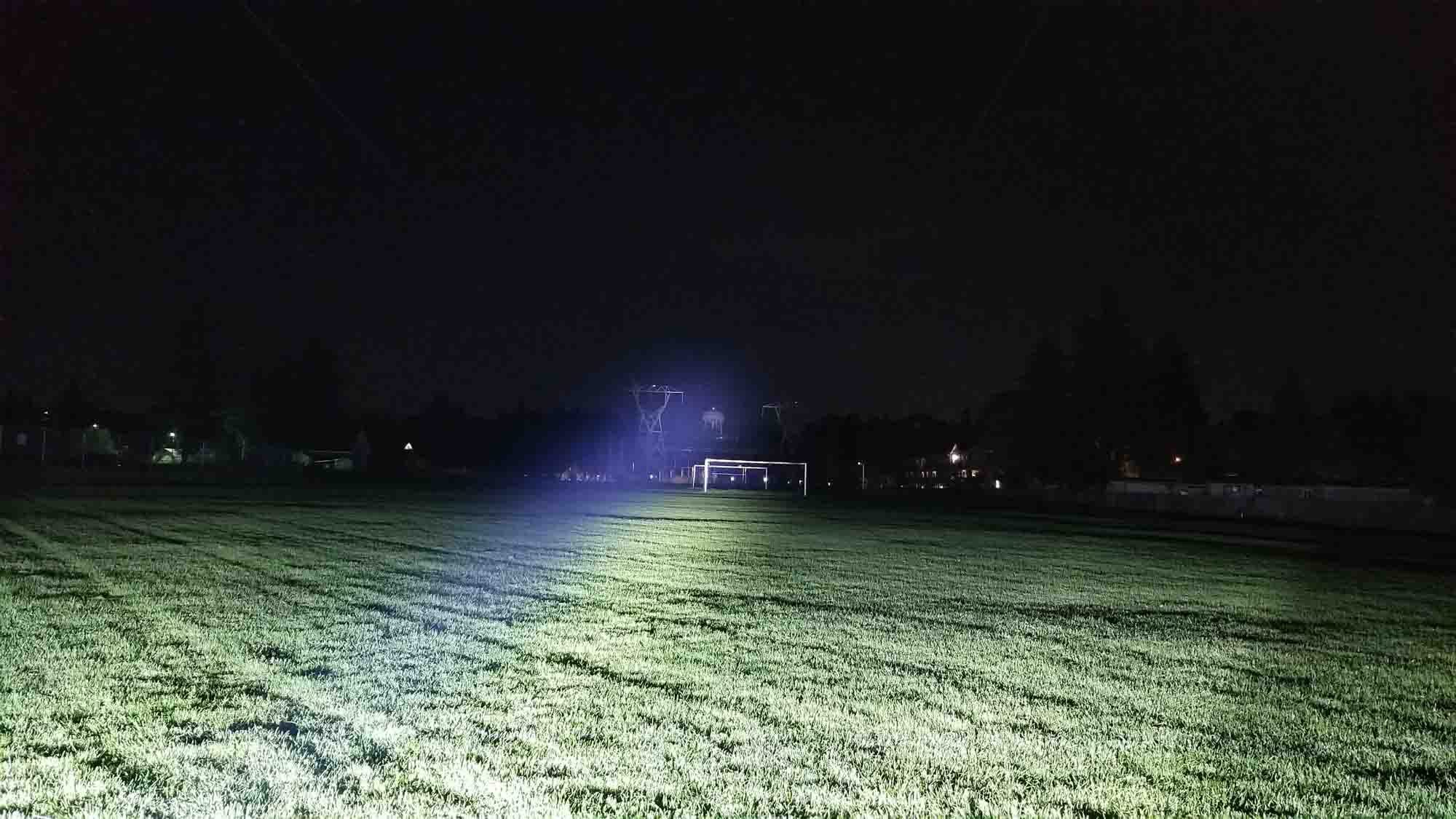
Disclaimer: This flashlight was sent to me for review at no cost by Fenix Lighting US. I have not been paid to review, nor have I been holding back on problems or defects.
Final Verdict
Pros
- Fantastic quality, fit and finish
- Great performance
- Relatively compact fo a searchlight
- Fully regulated driver
- Simple dual-switch UI
- 45 W USB PD charging (charger included!)
- PD power bank
Cons
- Only one o-ring?
- Plastic reflector on a $450 light
Explanation on star ratings:
1: Avoid: my phone flashlight would be a better choice – 2: Poor: significant defect or issues; almost unusable – 3: Average: some defects or issues; but still usable 4: Good: recommended (minor issues) – 5: Great: highly recommended

5 stars: ★★★★★
The adage goes that you get what you pay for. These days that can get a bit ambiguous and relative, but one thing you can count on is your money is well spent on a Fenix product.
Once again Fenix gives another example of why they’re one of the preeminent flashlight manufacturers in the world with the LR80R. Fresh off my Wuben A1 experience, testing the LR80R with “only” 18,000 Lumens and “only” 1000 m throw seemed a bit melodramatic, but it’s nonetheless a fantastic flashlight, high quality, and high performance with useful features like the power bank, 45 W charging, and a large carry handle with multiple mounting points and a shoulder strap. Although it’s a bit expensive, you get what you pay for, with no gimmicky features or complicated UIs.
You can count on the LR80R to be dependable and reliable for a long time, and if it does go bad, Fenix has you covered with their excellent warranty (ask me how I know that!). I couldn’t find too much to gripe about, other than I discovered it has a plastic reflector, and only one o-ring? Seriously? I liked how it’s easy to handle, relatively lightweight, and the performance is amazing with fully regulated output and excellent thermal management. This is a highly versatile light and I recommend it to anyone looking for a high performance, high quality illumination tool. 5 stars for the LR80R.
Buy Fenix LR80R with a discount
Get 10% off every purchase at Fenix Lighting US, by using our exclusive 1lumen discount code: 1lumen10
1lumen selects and reviews products personally. We may earn affiliate commissions through our links, which help support our testing.